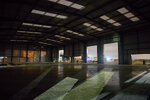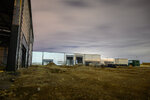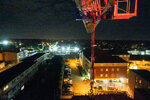Philosophy
At first this post might seem a little bland, but bear with me as it gets better across the entries, and I hope to add to continue adding to it. Building sites may seem a bit of a soulless if not strange thing to explore for their own sake, but I actually think it helps to remind us what urban exploration is truly about at heart. Abandonments are so popular now, there is often little actual sense of genuine new discovery. Furthermore, we end up documenting the same structures that everyone else has before. Construction sites provide a glimpse at a transient environment that you know will be totally different in only a few weeks time. You'll be the only one to capture that time and place in history, and can look back on these developments when they're functioning years into the future and say 'I saw that inside out from day one'. Furthermore, urbex at heart is about exploring the manmade environment that surrounds us. Building sites indeed form a key part of the places we inhabit, so who can blame me for wanting to get up close and personal.
This is why I ended up training my eagle eye for industrial developments being constructed around me in south Essex. Over the past century, the area has become transformed from a quaint rural expanse of suburbs to somewhere competitively developed for housing and commerce given its vital roadways and railways to and from London. These developments which seem incredibly mundane now form part of the story of the changing landscape. And besides, if these big developers wanna keep taking architectural dumps all over our backyard, who says we haven't got a right to experience them first hand.
Background
This set of loosley-connected explores began back in 2019 when I was finishing up my uni degree and basically busting my proverbial camera bag for an explore. After a brief hiatus I realised that urbex was basically what I wanted to do and was going to essentially become my life in absence of the social interaction I had at the time. Which turned out to be true! I was previously strictly a historical explorer (still my forte) but I'd become aware of the growing interest in rooftopping and inner city sites etc. I've never been much good at that, but I do admire the way it makes you try harder to access active places more creatively. Being so desperate, I was willing to think outside the box and try anything to get the juices flowing again, so as soon as a local warehouse site began construction, I called up my mate and said we're gonna give it a try. The good thing about not living in a city is that things can be way more discreet and less secure, and if a building site backs onto fields, job's a gooden.
One thing also to note is that all these photographs are long exposures largely taken in pitch-black darkness with the exception of light pollution.

Explore 1 - Canvey Warehouse (April 2019)
This was the first attempt, conquered in brief return to home turf. One thing I've learned is key with this, is to always take the longer safer route. You'll soon find out why, but luckily the learning curve only had to be learnt once. This fairly small building site at the time emerged on an area of fields I had once rambled through as a kid, with an abandoned farming complex isolated in the middle. This sat alongside the building development, which at the time was not much more than a load of flattened mud and a frame-like skeleton of a warehouse. I believe this is set to become a storage/trade unit for UK Shelving - how characterful. I also heard it might be a Screwfix but not sure about that.
Basically, we climbed in through the back over what was no more than a simple wooden palisade at waist height. After trekking through the fields we climbed up on the huge mountain of earth which had been deposited at one end. After taking pictures of ships fuelling up in the Thames Estuary, we peered down into the site from the cover of the mound to plan our route. After judging it to be unmanned, we crawled our way down onto the road-to-be running past the warehouse. Pretty rusty to the hobby and a bit terrified, as well as having to convince my mate this wasn't criminal, we inched our way to the warehouse. After taking a quick snap from the edge of the interior, we decided to take the quick way out given that not a soul was around. This is when being about a metre from the flimsy wooden gate, my mate pointed out a black sphere on a post that resembled an alarm. Next thing we knew, we were legging it down the road and into the darkness with an extremely loud alarm blaring throughout the entire area, whistling and repeating the message 'the police are on their way'. After making it far away enough, we realised we'd escaped. But it was a lesson learnt - never get complacent, it ain't over till its over.

Agriculture vs. Industry - this image of a small derelict farm building contrasted against the new development is a metaphor for the wider change the area is seeing

Peering in from the mound. An old oil refinery jetty is visible behind (one of my first childhood explores)

A Martian landscape



We joked 'there's no way we'd ever have the guts to climb that scaffold tower in the corner'
At first this post might seem a little bland, but bear with me as it gets better across the entries, and I hope to add to continue adding to it. Building sites may seem a bit of a soulless if not strange thing to explore for their own sake, but I actually think it helps to remind us what urban exploration is truly about at heart. Abandonments are so popular now, there is often little actual sense of genuine new discovery. Furthermore, we end up documenting the same structures that everyone else has before. Construction sites provide a glimpse at a transient environment that you know will be totally different in only a few weeks time. You'll be the only one to capture that time and place in history, and can look back on these developments when they're functioning years into the future and say 'I saw that inside out from day one'. Furthermore, urbex at heart is about exploring the manmade environment that surrounds us. Building sites indeed form a key part of the places we inhabit, so who can blame me for wanting to get up close and personal.
This is why I ended up training my eagle eye for industrial developments being constructed around me in south Essex. Over the past century, the area has become transformed from a quaint rural expanse of suburbs to somewhere competitively developed for housing and commerce given its vital roadways and railways to and from London. These developments which seem incredibly mundane now form part of the story of the changing landscape. And besides, if these big developers wanna keep taking architectural dumps all over our backyard, who says we haven't got a right to experience them first hand.

Background
This set of loosley-connected explores began back in 2019 when I was finishing up my uni degree and basically busting my proverbial camera bag for an explore. After a brief hiatus I realised that urbex was basically what I wanted to do and was going to essentially become my life in absence of the social interaction I had at the time. Which turned out to be true! I was previously strictly a historical explorer (still my forte) but I'd become aware of the growing interest in rooftopping and inner city sites etc. I've never been much good at that, but I do admire the way it makes you try harder to access active places more creatively. Being so desperate, I was willing to think outside the box and try anything to get the juices flowing again, so as soon as a local warehouse site began construction, I called up my mate and said we're gonna give it a try. The good thing about not living in a city is that things can be way more discreet and less secure, and if a building site backs onto fields, job's a gooden.
One thing also to note is that all these photographs are long exposures largely taken in pitch-black darkness with the exception of light pollution.
Explore 1 - Canvey Warehouse (April 2019)
This was the first attempt, conquered in brief return to home turf. One thing I've learned is key with this, is to always take the longer safer route. You'll soon find out why, but luckily the learning curve only had to be learnt once. This fairly small building site at the time emerged on an area of fields I had once rambled through as a kid, with an abandoned farming complex isolated in the middle. This sat alongside the building development, which at the time was not much more than a load of flattened mud and a frame-like skeleton of a warehouse. I believe this is set to become a storage/trade unit for UK Shelving - how characterful. I also heard it might be a Screwfix but not sure about that.
Basically, we climbed in through the back over what was no more than a simple wooden palisade at waist height. After trekking through the fields we climbed up on the huge mountain of earth which had been deposited at one end. After taking pictures of ships fuelling up in the Thames Estuary, we peered down into the site from the cover of the mound to plan our route. After judging it to be unmanned, we crawled our way down onto the road-to-be running past the warehouse. Pretty rusty to the hobby and a bit terrified, as well as having to convince my mate this wasn't criminal, we inched our way to the warehouse. After taking a quick snap from the edge of the interior, we decided to take the quick way out given that not a soul was around. This is when being about a metre from the flimsy wooden gate, my mate pointed out a black sphere on a post that resembled an alarm. Next thing we knew, we were legging it down the road and into the darkness with an extremely loud alarm blaring throughout the entire area, whistling and repeating the message 'the police are on their way'. After making it far away enough, we realised we'd escaped. But it was a lesson learnt - never get complacent, it ain't over till its over.
Agriculture vs. Industry - this image of a small derelict farm building contrasted against the new development is a metaphor for the wider change the area is seeing
Peering in from the mound. An old oil refinery jetty is visible behind (one of my first childhood explores)
A Martian landscape
We joked 'there's no way we'd ever have the guts to climb that scaffold tower in the corner'
Last edited:



 It makes for a fun challenge trying these sorts of 'clean' locations
It makes for a fun challenge trying these sorts of 'clean' locations
